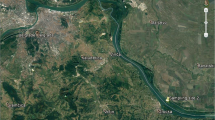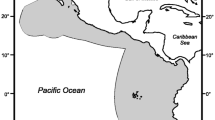Abstract
Muscle-metal (As, Se, Hg, Sn, Cr, Ni) levels were measured in little tunny (Euthynnus alletteratus) from the western Algerian stock. Relationships between metal levels in the muscle tissues and fish fork length and total weight were examined. The accumulation of metals in muscle tissues varied in the following ascending order: Ni, Cr, Sn, Hg, Se, and As. The range of metal concentrations (mg kg−1/wet weight) were 1.2561–3.8562 (As), 0.6897–3.4123 (Se), 0.3852–1.4235 (Hg), 0.1569–0.6512 (Sn), 0.1254–0.4002 (Cr), and 0.0719–0.3122 (Ni). Significant variations (t > 1.96, p < 0.05) between metal concentrations were observed in muscle tissues of E. alletteratus. The concentrations of all metals investigated increase as the fish increased in size and total weight. Furthermore, the results of exponential regressions showed significant positive relationships (p < 0.05) between metal levels and fish size and weight. Average levels of heavy metals in muscle tissues of E. alletteratus were lower than permissible limits for fish consumption prescribed by FAO/WHO, EC, ASTDR, and USFDA.



Similar content being viewed by others
References
Ansel MA, Benamar N (2018) Accumulation of heavy metals in muscle, liver, and gonads of little tunny (Euthynnus alletteratus) from the western region of Algeria. Environ Sci Pollut Res 25:32640–32648. https://doi.org/10.1007/s11356-018-3254-x
Teffer AK, Staudinger MD, Taylor DL, Juanes F (2014) Trophic influences on mercury accumulation in top pelagic predators from offshore New England waters of the northwest Atlantic Ocean. Mar Environ Res 101:124–134. https://doi.org/10.1016/j.marenvres.2014.09.008
Cai Y, Rooker JR, Gill GA, Turner JP (2007) Bioaccumulation of mercury in pelagic fishes from the northern Gulf of Mexico. Can J Fish Aquat Sci 64:458–469. https://doi.org/10.1139/F07-017
Canli M, Atli G (2003) The relationships between heavy metal (Cd, Cr, Cu, Fe, Pb, Zn) levels and the size of six Mediterranean fish species. Environ Pollut 121:129–136. https://doi.org/10.1016/S0269-7491(02)00194-X
Liu JL, Xu XR, Ding ZH, Peng JX, Jin MH, Wang YS, Hong YG, Yue WZ (2015) Heavy metals in wild marine fish from South China Sea: levels, tissue- and species-specific accumulation and potential risk to humans. Ecotoxicology 24:1583–1592. https://doi.org/10.1007/s10646-015-1451-7
Kennedy CJ (2011) The toxicology of metals in fishes. In: Farrell AP (ed) Encyclopedia of fish physiology: from genome to environment, vol 3. Academic, San Diego, pp 2061–2068
Adams DH (2004) Total mercury levels in tunas from offshore waters of the Florida Atlantic coast. Mar Pollut Bull 49:659–663. https://doi.org/10.1016/j.marpolbul.2004.06.005
Hall RA, Zook EG, Meaburn GM (1978) National marine fisheries service survey of trace elements in the fishery resource. NOAA Technical Report NMFS SSRF-721, U.S. Department of Commerce, National Marine Fisheries Service, 313 pp
Kuklyte L, Rowe G (2012) Mercury contamination in pelagic fishes of the Gulf of Mexico. Atiner’s Conference Paper Series. Env 2012:0366
Moura Reis Manhães B, de Souza PA, Bisi TL et al (2020) Tracking mercury in the southwestern Atlantic Ocean: the use of tuna and tuna-like species as indicators of bioavailability. Environ Sci Pollut Res 27:6813–6823. https://doi.org/10.1007/s11356-019-07275-4
Amiard JC, Pineau A, Boiteau HL, Métayer C, Amiard-Triquet C (1987) Application of atomic absorption spectrophotometry using Zeeman effect to the determination of eight trace elements (Ag, Cd, Cr, Cu, Mn, Ni, PB and Se) in biological materials. Water Res 21:693–697. https://doi.org/10.1016/0043-1354(87)90081-9
FAO (1997) Review of the state of world fishery resources: marine fisheries. Marine Resource Service, Fishery Resources Division, Fisheries Department, eds. FAO Fisheries Circular No. 920 FIRM/C920. ISSN 0429-9329. FAO, Rome
Aposhian HV, Zakharyan RA, Wildfang EK et al (1999) How is inorganic arsenic detoxified? Arsen Expo Heal Eff III:289–297. https://doi.org/10.1016/b978-008043648-7/50033-9
Ralston NVC, Blackwell JL, Raymond LJ (2007) Importance of molar ratios in selenium-dependent protection against methylmercury toxicity. Biol Trace Elem Res 119:255–268. https://doi.org/10.1007/s12011-007-8005-7
Raymond LJ, Ralston NVC (2009) Selenium’s importance in regulatory issues regarding mercury. Fuel Process Technol 90:1333–1338. https://doi.org/10.1016/j.fuproc.2009.07.012
Kehrig HA, Seixas TG, Di Beneditto APM, Malm O (2013) Selenium and mercury in widely consumed seafood from South Atlantic Ocean. Ecotoxicol Environ Saf 93:156–162. https://doi.org/10.1016/j.ecoenv.2013.03.034
Yamashita Y, Amlund H, Suzuki T, Hara T, Hossain MA, Yabu T, Touhata K, Yamashita M (2011) Selenoneine, total selenium, and total mercury content in the muscle of fishes. Fish Sci 77:679–686. https://doi.org/10.1007/s12562-011-0360-9
Hamilton SJ (2003) Review of residue-based selenium toxicity thresholds for freshwater fish. Ecotoxicol Environ Saf 56:201–210. https://doi.org/10.1016/S0147-6513(02)00091-X
Berry MJ, Ralston NVC (2008) Mercury toxicity and the mitigating role of selenium. Ecohealth 5:456–459. https://doi.org/10.1007/s10393-008-0204-y
Janz DM (2011) Chap. 7 Selenium. In: Chris M, Wood APF, Colin JB (eds) Fish physiology, vol 31. Part A. Academic Press, New York, pp 327–374
Kaneko JJ, Ralston NVC (2007) Selenium and mercury in pelagic fish in the central North Pacific near Hawaii. Biol Trace Elem Res 119:242–254. https://doi.org/10.1007/s12011-007-8004-8
Storelli MM, Giacominelli-Stuffler R, Storelli A, Marcotrigiano GO (2005) Accumulation of mercury, cadmium, lead and arsenic in swordfish and bluefin tuna from the Mediterranean Sea: a comparative study. Mar Pollut Bull 50:1004–1007. https://doi.org/10.1016/j.marpolbul.2005.06.041
Ashraf M, Jaffar M (1988) Weight dependence of arsenic concentration in the Arabian Sea tuna fish. Bull Environ Contam Toxicol 40:219–225. https://doi.org/10.1007/BF01881042
Ayotte P, Éric D, Bruneau S et al (1995) Arctic air pollution and human health: what effects should be expected? Sci Total Environ 160–161:529–537. https://doi.org/10.1016/0048-9697(95)04387-G
Kojadinovic J, Potier M, Le Corre M et al (2007) Bioaccumulation of trace elements in pelagic fish from the Western Indian Ocean. Environ Pollut 146:548–566. https://doi.org/10.1016/j.envpol.2006.07.015
Licata P, Trombetta D, Cristani M, Naccari C, Martino D, Caló M, Naccari F (2005) Heavy metals in liver and muscle of bluefin tuna (Thunnus thynnus) caught in the straits of Messina (Sicily, Italy). Environ Monit Assess 107:239–248. https://doi.org/10.1007/s10661-005-2382-1
Bosch AC, O’Neill B, Sigge GO, Kerwath SE, Hoffman LC (2016) Mercury accumulation in Yellowfin tuna (Thunnus albacares) with regards to muscle type, muscle position and fish size. Food Chem 190:351–356. https://doi.org/10.1016/j.foodchem.2015.05.109
Datta S, Ghosh D, Saha DR, Bhattacharaya S, Mazumder S (2009) Chronic exposure to low concentration of arsenic is immunotoxic to fish: role of head kidney macrophages as biomarkers of arsenic toxicity to Clarias batrachus. Aquat Toxicol 92:86–94. https://doi.org/10.1016/j.aquatox.2009.01.002
Sanz E, Muñoz-Olivas R, Cámara C (2005) Evaluation of a focused sonication probe for arsenic speciation in environmental and biological samples. J Chromatogr A 1097:1–8. https://doi.org/10.1016/j.chroma.2005.08.012
Besada V, González JJ, Schultze F (2006) Concentraciones de mercurio, cadmio, plomo, arsénico, cobre y zinc en atún blanco, rabil y patudo procedentes del Oca̧no Atlántico. Ciencias Mar 32:439–445
Chen CY, Chen YT, Chen KS, Hsu CC, Liu LL, Chen HS, Chen MH (2018) Arsenic and five metal concentrations in the muscle tissue of Bigeye tuna (Thunnus obesus) in the Atlantic and Indian Oceans. Mar Pollut Bull 129:186–193. https://doi.org/10.1016/j.marpolbul.2018.02.028
Nam SH, Oh HJ, Min HS, Lee JH (2010) A study on the extraction and quantitation of total arsenic and arsenic species in seafood by HPLC-ICP-MS. Microchem J 95:20–24. https://doi.org/10.1016/j.microc.2009.08.009
Reid SD (2012) Molybdenum and chromium. In: Wood CM, Farrell AP, Brauner CJ (eds) Fish physiology: homeostasis and toxicology of essential metals, vol 31A. Academic, London, pp 375–415
Triebskorn R, Köhler HR, Flemming J, Braunbeck T, Negele RD, Rahmann H (1994) Evaluation of bis(tri-n-butyltin)oxide (TBTO) neurotoxicity in rainbow trout (Oncorhynchus mykiss). I. Behaviour, weight increase, and tin content. Aquat Toxicol 30:189–197. https://doi.org/10.1016/0166-445X(94)90057-4
Al-Busaidi M, Yesudhason P, Al-Rabhi W et al (2015) Fatty acid profile and selected chemical contaminants in yellowfin tuna from the Arabian Sea. Int J Food Prop 18:2764–2775. https://doi.org/10.1080/10942912.2015.1013631
Chouvelon T, Brach-Papa C, Auger D, Bodin N, Bruzac S, Crochet S, Degroote M, Hollanda SJ, Hubert C, Knoery J, Munschy C, Puech A, Rozuel E, Thomas B, West W, Bourjea J, Nikolic N (2017) Chemical contaminants (trace metals, persistent organic pollutants) in albacore tuna from western Indian and south-eastern Atlantic Oceans: trophic influence and potential as tracers of populations. Sci Total Environ 596–597:481–495. https://doi.org/10.1016/j.scitotenv.2017.04.048
Hussein A, Khaled A (2014) Determination of metals in tuna species and bivalves from Alexandria, Egypt. Egypt J Aquat Res 40:9–17. https://doi.org/10.1016/j.ejar.2014.02.003
Padula DJ, Daughtry BJ, Nowak BF (2008) Dioxins, PCBs, metals, metalloids, pesticides and antimicrobial residues in wild and farmed Australian southern bluefin tuna (Thunnus maccoyii). Chemosphere 72:34–44. https://doi.org/10.1016/j.chemosphere.2008.02.029
Araújo CVM, Cedeño-Macias LA (2016) Heavy metals in yellowfin tuna (Thunnus albacares) and common dolphinfish (Coryphaena hippurus) landed on the Ecuadorian coast. Sci Total Environ 541:149–154. https://doi.org/10.1016/j.scitotenv.2015.09.090
Watras CJ, Back RC, Halvorsen S, Hudson RJM, Morrison KA, Wente SP (1998) Bioaccumulation of mercury in pelagic freshwater food webs. Sci Total Environ 219:183–208. https://doi.org/10.1016/S0048-9697(98)00228-9
ASTDR (2003) Toxicological profile for selenium, Department of Health and Human Service. Public Health Service, Public Health Service. Agency for Toxic Substances and Disease Registry, Atlanta, p 599
European Commission (EC) (2003) COMMISSION DIRECTIVE 2003/100/EC of 31 October 2003 amending Annex I to Directive 2002/32/EC of the European Parliament and of the Council on undesirable substances in animal feed. Off J Eur Union 46:33–37
European Commission (EC) (2005) Commission Regulation (EC) No. 78/2005 of 19th January 2005. Amending Regulation (EC) No 466/2001 as regards heavy metals. Off J Eur Union L 16/43
WHO/FAO (2015) (World Health Organization/Food and Agriculture Organization). Codex Alimentarius Commission General Standard for Contaminants and Toxins in Food and Feed. CODEX STAN, p 193–1995
USFDA (1993) Food and drug administration. Guidance document for chromium in shellfish. DHH S/PHS/FDA/CFSAN / Office of Seafood, Washington
USFDA (1993) Food and drug administration, Guidance document for nickel in shell fish. DHHS/PHS/ FDA/CFSAN/office of seafood, Washington D.C.
Author information
Authors and Affiliations
Corresponding author
Ethics declarations
Conflict of interest
The author declares that there is no conflict of interest.
Ethical approval
Fish was purchased from commercial fish markets and retail markets in western Algeria (Mostaganem, Chlef, Oran).
Additional information
Publisher’s Note
Springer Nature remains neutral with regard to jurisdictional claims in published maps and institutional affiliations.
Rights and permissions
About this article
Cite this article
Ansel, M.A. Hg, As, Cr, Sn, Ni, and Se concentrations in the muscle of little tunny (Euthynnus alletteratus) from the western Algerian stock. Biol Trace Elem Res 199, 3898–3904 (2021). https://doi.org/10.1007/s12011-020-02514-z
Received:
Accepted:
Published:
Issue Date:
DOI: https://doi.org/10.1007/s12011-020-02514-z




